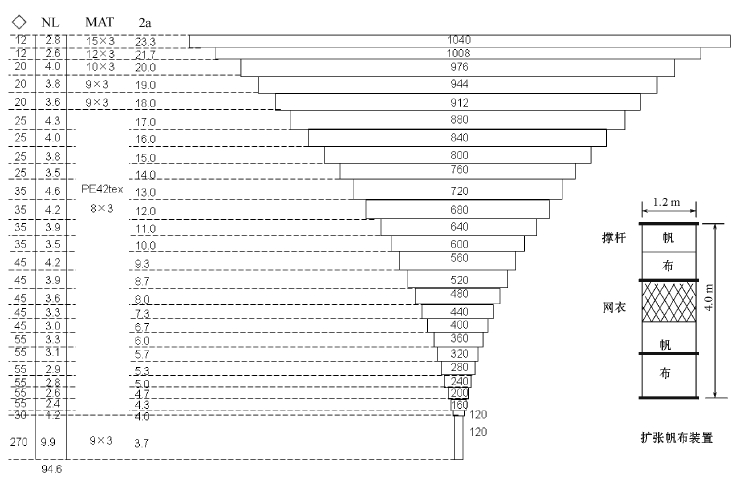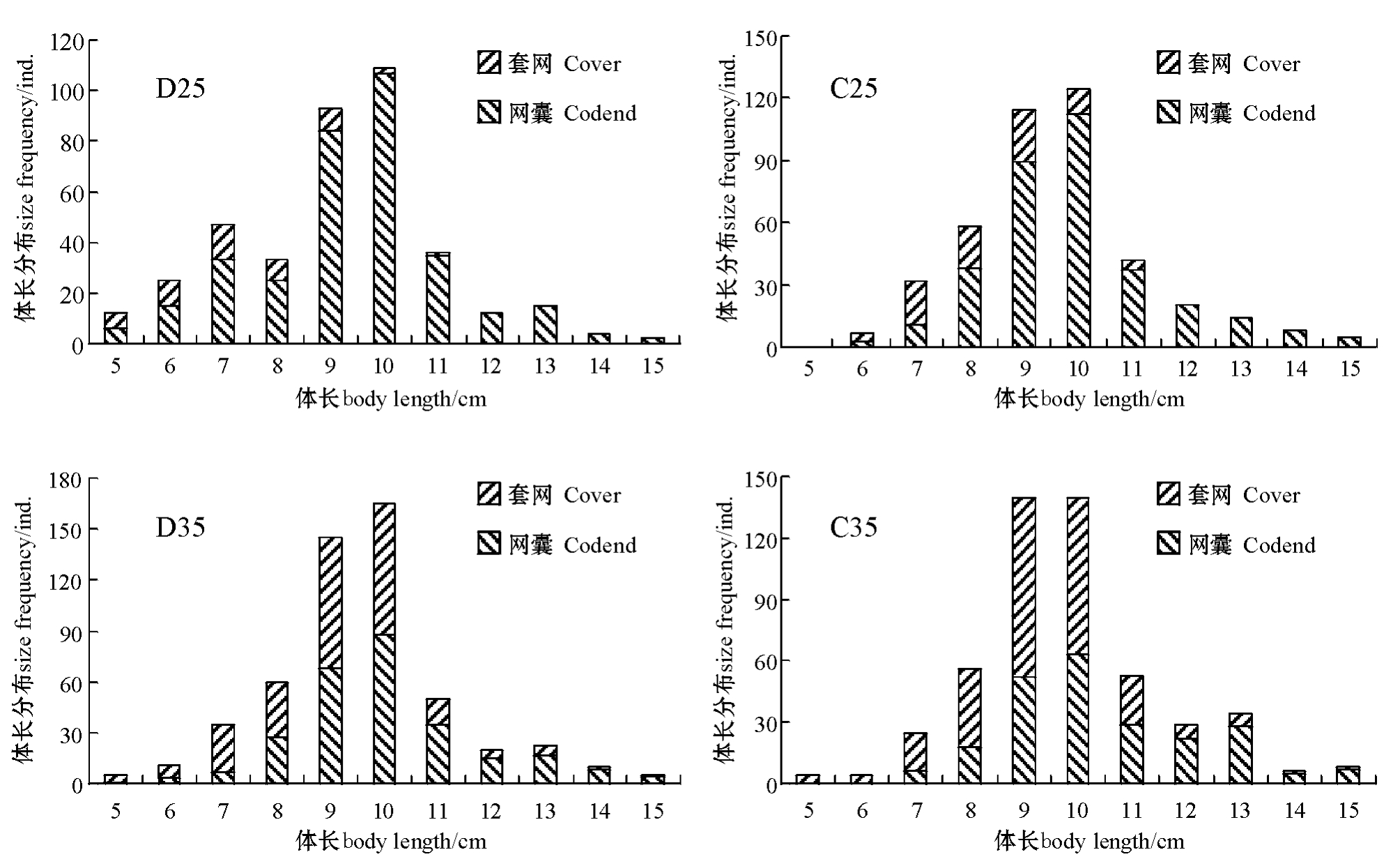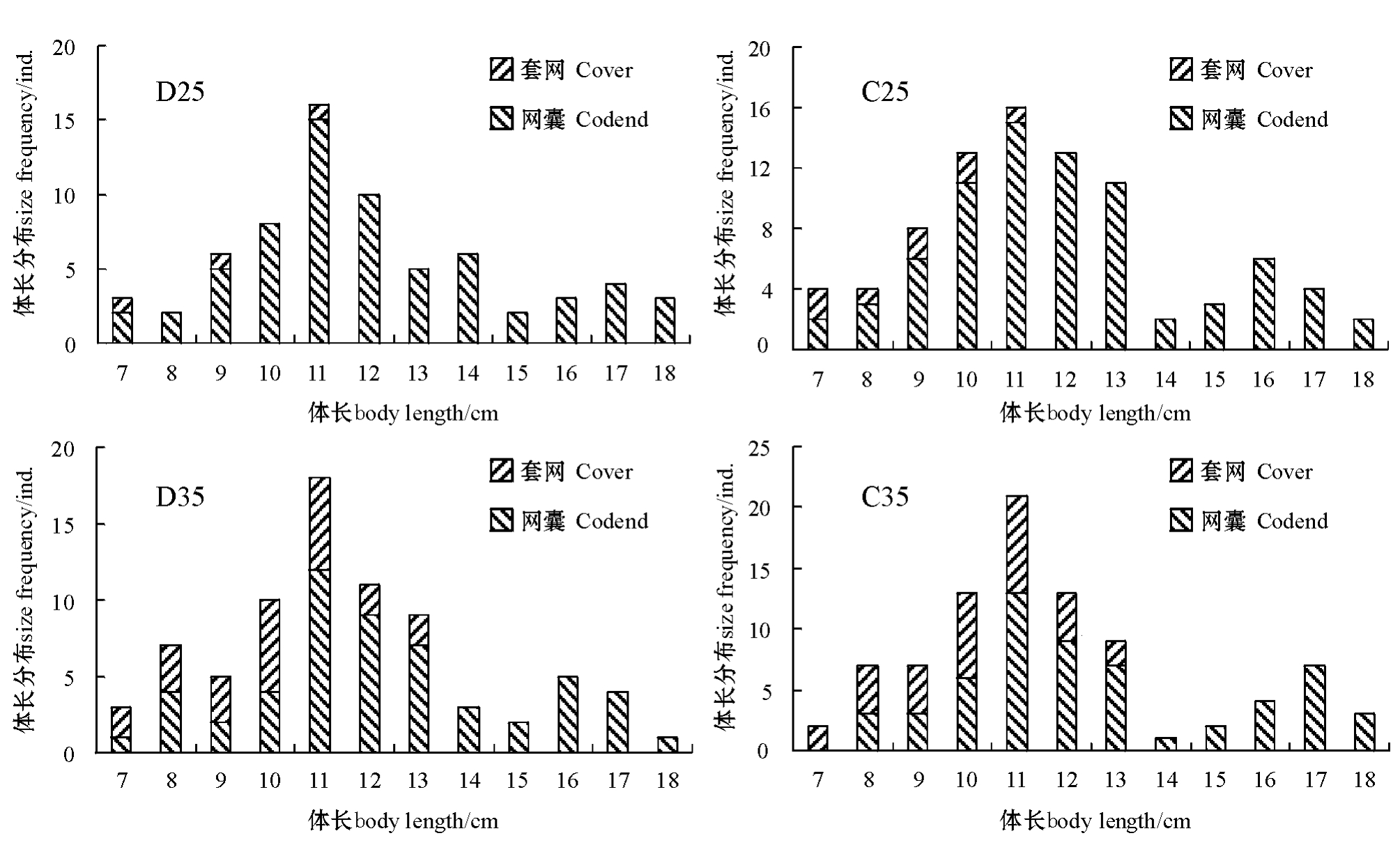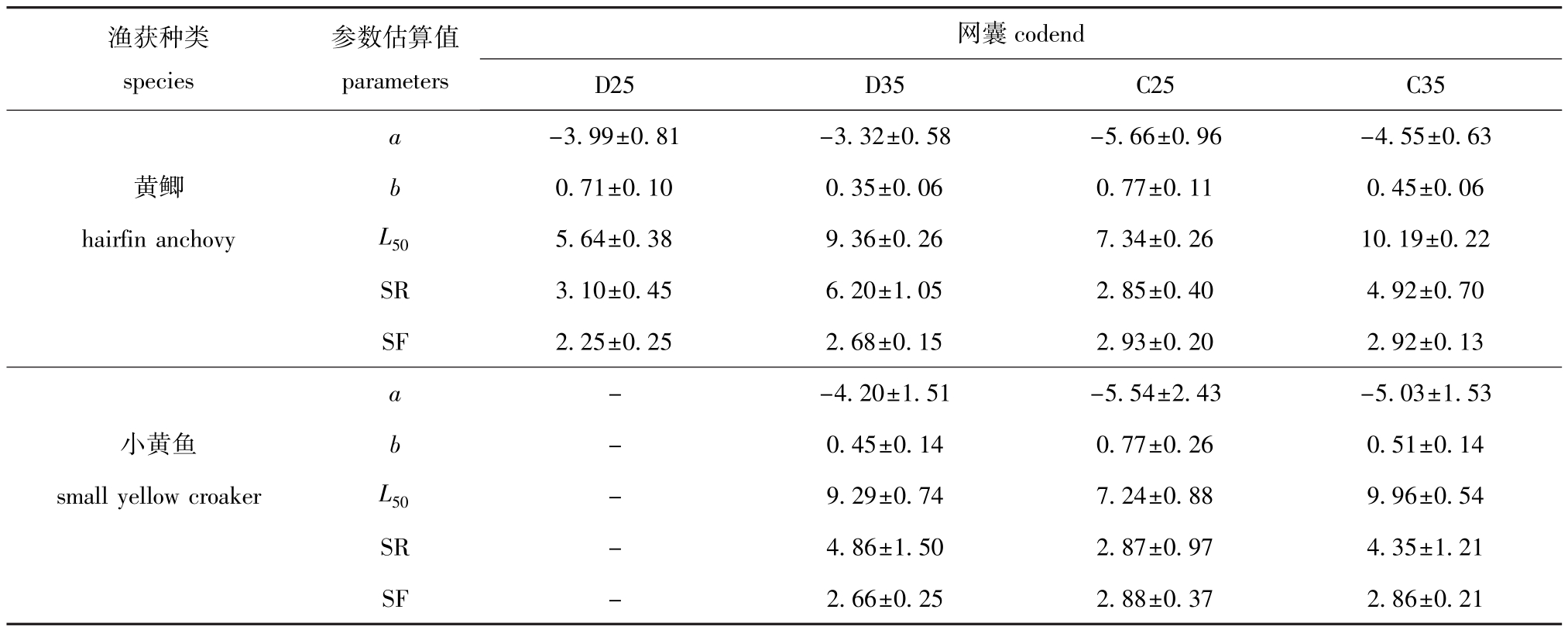
图1 网衣展开图
Fig.1 Net drawing of the experimental fishing gear
张健1,石建高2,彭永章3,陈小康1
(1.大洋渔业资源可持续开发省部共建教育部重点实验室,上海海洋大学,上海201306;2.农业部海洋与河口渔业重点实验室,中国水产科学研究院东海水产研究所,上海200090;3.江苏省启东市海洋与渔业局,江苏启东226200)
摘要:改变网囊周长是改善过滤性渔具网囊选择性的主要技术措施之一。为了评价网囊周长对中国近海渔业使用的单桩张网网囊选择性的影响,使用套网试验法对不同网目尺寸(25 mm和35 mm)的传统网囊和减小30%周长的网囊进行选择性试验,并对黄鲫Setipinna taty和小黄鱼Pseudosciaena polyactis渔获体长数据的选择性进行了分析。结果显示:减小网囊周长可改善对渔获体长的选择性,即减小周长的网囊的50%选择体长(L50)较传统网囊大,而选择范围较小,对于较小的个体,选择性得到较为明显的改善;对比其它文献的研究结果,减小30%周长的网囊的L50要比相同网目尺寸的菱形和方形网目网囊大,但网囊周长对其尺寸选择性影响的具体规律有待于进一步研究。
关键词:单桩张网;尺寸选择性;网囊周长;黄鲫;小黄鱼
张网捕捞是中国近海渔业的主要作业方式之一,但由于张网渔具网囊网目的尺寸较小,渔获物中幼鱼的比例较高,因而对渔业资源的养护造成了严重的影响。对于多数过滤性渔具来说,改善渔具网囊的选择性是提高渔具渔获性能、保护渔业资源的主要技术措施[1-2]。越来越多的研究证实,除了增大网囊网目尺寸以外,通过改变网目形状或者网囊结构以增加网目的扩张性,也是改善过滤性渔具选择性的方法。如使用方形网目[3-6]、六角形网目[7-9]、复合网目[10-11]和转向网目(菱形网目转向90°使用)网囊[12-13]代替传统菱形网目网囊,以及改变网囊周长[14-18],改变网线粗度[19-21],使用不同的网线材料等[22]。孙满昌等[4,23]认为,对于近海渔业使用的张网渔具,方形网目网囊并不能改善渔具对所有渔获的尺寸选择性,且渔民对于使用方形网目网囊这类对传统网囊工艺改动较大的措施普遍存在一定的抵触情绪。为此,笔者于2008年5月和2009年5月在吕四渔场进行了不同周长的单桩张网渔具网囊的尺寸选择性试验,以期为进一步优化张网渔具的渔获性能,实现渔业可持续发展提供基础数据,同时通过评价网囊周长对网囊选择性的影响,也为今后进行过滤性渔具选择性研究提供参考。
1.1 作业时间和作业区域
单桩张网渔具不同周长网囊选择性试验分两个阶段进行:第一阶段作业时间为2008年5月4日—5月21日,作业区域为32°18′N~32°31′N, 122°22′E~122°32′E;第二阶段作业时间为2009年5月16日—5月28日,作业区域为32°26′N~32°47′N,122°34′E~122°45′E。作业渔场水深为20~24 m,渔场潮流为正规半日潮,流速为0.67~0.87 m/s,底质为泥沙质。
1.2 渔船和渔具
试验渔船为“苏启渔1302”号,该船排水量为90 t,主机功率为183 kW。试验网具为实际生产中使用的网具(图1)。与传统单桩桁杆张网渔具相比,其扩张装置中采用帆布框架来代替桁杆。网具网口的左右两边各配置5块扩张帆布,每块帆布的规格为1.2 m×4.0 m,帆布使用撑杆支撑,撑杆的材料为铁管(Φ=70 mm)。使用帆布代替桁
杆作为扩张装置,既改良了作业渔具的结构,又能保证张网的作业性能。近5年来,在江苏吕四渔场基本用该网具代替了传统桁杆张网,使用此网具作业的渔船有数百艘。

图1 网衣展开图
Fig.1 Net drawing of the experimental fishing gear
1.3 试验项目和方法
选用网囊网目内径为25 mm和35 mm的传统网囊(平时作业使用的网囊规格)和拉紧周长减少30%的网囊进行选择性试验。采用套网法作为选择性试验方法[24]。通过比较各网囊和套网中的渔获组成,分析不同周长的网囊对渔获对象的选择率。各试验网囊和套网的具体规格如表1所示。
表1 试验网囊和套网的规格
Tab.1 The specification of the experimental and control codends

网囊编号网目内径网囊规格dimension/目codend No.传统结构网囊codend inner mesh size/mm名义值nominal实测均值±标准差mean±standard deviation 横向width纵向length 2525.09±0.44210160C25 circumference reduction codend3534.87±0.35145115C35 2525.09±0.44320160D25 traditional codend3534.87±0.35226115D35减小周长套网cover2019.40±0.37600300-
试验中,选取4顶网具作为试验网具,分别使用不同网目尺寸的传统网囊和减小周长30%的网囊替换原网囊,并在网囊外安装小网目套网,每航次进行5网次的有效试验,共进行了40个有效网次的试验。在每顶张网选择性试验中,作业地点、作业时间以及渔具的起放网操作均与原有生产渔具
相同,每顶网具每天起放网一次,平均网次作业时间为24 h。试验过程中,未出现航次内网具改变作业位置的情况。
试验网具起网后,对各网具网囊和套网中的渔获物进行分类,对渔获数量较多的种类分别取样、称重,并进行渔获体长、体质量等常规生物学数据的测量,按1/4的比例取样。
1.4 选择性分析方法
根据张健等[25]对张网渔具选择性曲线的讨论,选用Logistic曲线作为张网渔具选择性曲线模型,即
其中:Sl为网囊对l体长个体的选择率;l表示渔获体长;a和b为需要估算的选择性参数。
选择性指标分别为
50%选择体长L50=-a/b,
选择范围(SR)=2ln 3/b,
选择因素(SF)=L50/m,
其中:m为网目尺寸(mm)。
使用Select模型作为选择性分析基本模型[23,26],采用极大似然估计法进行模型参数估算,对数似然函数为
其中:Nl1和Nl2分别为网囊和套网中捕获的l体长渔获的数量。
在极大似然估计法中,根据费歇信息矩阵计算选择性参数的方差,并根据Delta方法计算选择性指标的方差[27-28]。
2.1 主要渔获种类的体长分布
在选择性试验中,鱼类作为主要捕捞对象,其渔获量约占总渔获质量的80%,渔获数量最多的种类为黄鲫Setipinna taty,其次为小黄鱼Pseudosciaena polyactis、日本鯷Engraulis japonicus、银鲳Pampus echinogaster、黄鮟鱇Lophius litulon、焦氏舌鳎Cynoglossus joyneri、棘头梅童鱼Collichthys lucida等。由于选择性研究需要足够的渔获数量,因此本研究中仅对渔获数量较多的黄鲫和小黄鱼进行了选择性分析。
由于单一网次渔获数量较少,无法完成选择性曲线的拟合,因此使用了累加多个网次的渔获进行选择性分析。不同网目尺寸、不同周长的网囊捕获的黄鲫和小黄鱼的渔获体长分布见图2、图3。

图2 用不同网囊捕获的黄鲫渔获体长的分布
Fig.2 Size(body length)frequency of hairfin anchovy caught by different codends and covers

图3 用不同网囊捕获的小黄鱼渔获体长的分布
Fig.3 Size(body length)frequency of small yellow croaker caught in different codends and covers
2.2 选择性分析
利用Logistic曲线作为选择性曲线,对不同网囊所捕获的黄鲫和小黄鱼渔获体长分布进行拟合,得到选择性参数和选择性指标如表2所示,选择性曲线如图4所示。由于网目尺寸25 mm的传统网囊几乎捕获了所有的小黄鱼个体,10个网次的试验中套网仅捕获3尾小黄鱼,因此未作选择性分析。
表2 不同网囊对黄鲫和小黄鱼的选择性参数及选择性指标
Tab.2 Selectivity parameters and indexes of hairfin anchovy and small yellow croaker in experimental codends

渔获种类species参数估算值parameters网囊codend D25D35C25C35 a -3.99±0.81-3.32±0.58-5.66±0.96-4.55±0.63 -4.20±1.51-5.54±2.43-5.03±1.53小黄鱼b-0.45±0.140.77±0.260.51±0.14 small yellow croakerL50-9.29±0.747.24±0.889.96±0.54 SR-4.86±1.502.87±0.974.35±1.21黄鲫b0.71±0.100.35±0.060.77±0.110.45±0.06 hairfin anchovyL505.64±0.389.36±0.267.34±0.2610.19±0.22 SR3.10±0.456.20±1.052.85±0.404.92±0.70 SF2.25±0.252.68±0.152.93±0.202.92±0.13 a -SF-2.66±0.252.88±0.372.86±0.21
对比不同周长的网囊对黄鲫和小黄鱼的选择性(表2、图4),不难看出,对于黄鲫和小黄鱼,通过减小网囊周长可以改善网囊网目的尺寸选择性,即减小周长的网囊的50%选择体长(L50)较传统网囊大,而选择范围较小。对于黄鲫,减少周长网囊的L50分别比传统网囊大30.1%(网目尺寸为25
mm)和8.87%(网目尺寸为35 mm),而选择范围分别比传统网囊小8.07%(网目尺寸为25 mm)和20.1%(网目尺寸为35 mm);对于小黄鱼,减少周长网囊的L50比传统网囊大7.21%,而选择范围小10.5%(网目尺寸为35 mm)。通过上述对比发现,对于网目尺寸为35 mm的两种网囊,减小周长对L50的影响相对较小,但选择范围都减小,选择性曲线变得更为陡峭。不仅如此,对比选择性曲线还发现,减小周长的网囊对于个体较小的黄鲫和小黄鱼的选择性优于传统网囊,如对于体长6~9 cm的黄鲫和体长9~11 cm的小黄鱼,减小周长的网囊平均估算释放率比传统网囊分别小0.10和0.08。

图4 不同网囊对黄鲫和小黄鱼的选择性曲线
Fig.4 Selectivity curves of hairfin anchovy,and small yellow croaker in the experimental codends
水下观察发现,渔获进入拖网网囊后,其逃逸行为主要发生在网囊前部网目张开的区域,因此,增大网囊网目的扩张(减少网囊周向目数)可改善渔具的选择性[14,29]。这一观点在北海拖网渔业[15,30]、澳大利亚新南威尔士捕虾拖网渔业[16]、土耳其爱琴海拖网渔业[17,31]和澳大利亚东南沿海拖网渔业[32]的选择性试验中都得以证实。然而,也有一些研究结果显示,改变网囊的周长并不能改善渔具的选择性。如同样在土耳其爱琴海东部拖网渔业[33]和澳大利亚捕虾拖网渔业[18]中的相关研究结果显示,减小网囊周长后网囊的渔获与普通网囊相比无显著变化,选择率差异不大,甚至周长较长的网囊渔获质量较好。Lök等[17]认为,减小周长的网囊对不同种类的选择性影响与个体的体型相关,对于体型扁平的鱼类,减小周长的网囊并不能有效改善其选择性。
从本次选择性试验结果来看,对比传统网囊,减小周长使得张网渔具网囊对黄鲫和小黄鱼的尺寸选择性有所改善,特别是对较小的个体,这为今后改善张网渔具选择性提供了潜在的新技术手段。虽然还没有研究证实网囊周长对选择范围的影响如何,但值得注意的是,减小周长的网囊对黄鲫和小黄鱼的选择范围都有所减小,表现在选择性曲线更加陡峭,这有助于通过控制网目尺寸实现张网渔具的选择性捕捞。
本研究中所使用的渔具是江苏吕四渔场近年来逐渐兴起的一种使用帆布作为扩张装置的新型张网渔具。该渔具是在传统的单桩桁杆张网渔具基础上发展而来,作业时间和作业区域与传统的单桩桁杆张网渔具基本相同,渔获组成也相近。将本试验结果与孙满昌等[4,23]对传统桁杆张网网囊网目选择性分析结果进行比较,可以发现,相同网目尺寸的传统网囊对不同种类的选择率较为接近,无论是对黄鲫还是小黄鱼,选择因素和选择范围都差异不大。因此,笔者认为,两次试验的结果具有可比性。与传统菱形网目和方形网目[12,34]对黄鲫和小黄鱼的选择性进行比较,结果发现:减小周长的网囊的L50较菱形网目和方形网目的大,但方形网目网囊的选择范围最小,减小周长网囊的次之,菱形网目网囊的最大。
引起不同网囊选择性指标差异的具体原因目前并不明确。笔者认为,菱形网目、方形网目和减小周长的网囊可代表3种不同的网目张开形式:传统菱形网目网囊在实际作业中,网囊和网囊头部分的网衣除了集鱼部前部部分网衣张开以外,其余网目基本闭合,这就阻碍了进入网囊的渔获个体逃逸;
方形网目网囊对于小黄鱼具有较好的选择性,但是对于黄鲫,其L50也较小,表明网目张开过大也不利于部分鱼类逃逸,这可能与黄鲫种类的个体体形与网囊网目形状的匹配程度以及个体在进入网具以后的游泳能力有关[4,35-36]。而适当张开网目,如本试验中减小30%的网囊周长而使网囊网目扩张,网囊对黄鲫和小黄鱼的选择率都有所改善。当然,由于本试验中作业网次的数量有限,而且作业地点相对比较集中,研究结果可能有一定的局限性,需要进一步研究加以证实。
本试验结果显示,减小网囊周长可以改善网囊的尺寸选择性,但到底减小多少周长才是最佳的选择却很难获知。O’Neill等[30]在北海鱼类拖网中,将原有周向120目的网囊缩减到100、80和60目来评价缩小网囊周向目数对渔具选择性的影响,结果显示周向目数越小,选择性越佳。但对于张网渔具,还需要进行更多不同周长的网囊对比试验才能掌握周长对选择性影响的具体规律。当然,由于网囊周长的减小,势必会对网囊的形状、受力等产生影响,因此,需要在水槽中进行试验或者在数值模拟等方面做进一步的研究。
参考文献:
[1] Armstrong D W,Ferro R S T,MacLennan D N,et al.Gear selectivity and the conservation of fish[J].J Fish Biol,1990,37(sa):261 -262.
[2] Maclennan D N.Fishing gear selectivity[J].Fish Res,1992,13 (3):201-204.
[3] Casey J,Nicholson M D,Warnes S.Selectivity of square mesh codends of pelagic trawls for Atlantic mackerel(Scomber scombrus L.)[J].Fish Res,1992,13(3):267-279.
[4] Sun M C,Zhang J,Xu L X.Size selectivity of diamond and square mesh codends for hairfin anchovy Setipinna taty in Chinese stow net fisheries[J].Fish Sci,2006,72(3):530-539.
[5] Lucchetti A.Comparison of diamond-and square-mesh codends in the hake(Merluccius merluccius L.1758)trawl fishery of the Adriatic Sea(Central Mediterranean)[J].Sci Mar,2008,72(3):451 -460.
[6] Broadhurst M K,Millar R B,Brand C P.Diamond-vs.squaremesh codend selectivity in southeastern Australian estuarine squid trawls[J].Fish Res,2010,102(3):276-285.
[7] Aydin C,Tosuno¨glu Z.Selectivity of square and hexagonal mesh codends for the deep water rose shrimp,Parapenaeus longirostris (Lucas,1846)(Decapoda,Penaeidae)in the Aegean Sea[J]. Crustaceana,2009,82(1):89-98.
[8] Tosuno¨glu Z,Aydin C,Salman A,et al.Selectivity of diamond,hexagonal and square mesh codends for three commercial cephalopods in the Mediterranean[J].Fish Res,2009,97(1-2):95-102.
[9] Aydin C,Tosuno¨glu Z.Selectivity of diamond,square and hexagonal mesh codends for Atlantic horse mackerel Trachurus trachurus, European hake Merluccius merluccius,and greater forkbeard Phycis blennoides in the eastern Mediterranean[J].J Appl Ichthyol, 2010,26(1):71-77.
[10] Broadhurst M K,Kangas M I,Damiano C,et al.Using composite square-mesh panels and the Nordm regrid to reduce bycatch in the Shark Bay prawn-trawl fishery,Western Australia[J].Fish Res, 2002,58(3):349-365.
[11] Broadhurst M K.Modifications to reduce bycatch in prawn trawls: A review and framework for development[J].Rev Fish Biol Fish, 2000,10(1):27-60.
[12] 张健,孙满昌.桁拖网不同网目结构网囊对主要鱼类的选择性研究[J].上海水产大学学报,2008,17(4):457-463.
[13] Herrmann B,Priour D,Krag L A.Simulation-based study of the combined effect on codend size selection of turning meshes by 90° and reducing the number of meshes in the circumference for round fish[J].Fish Res,2007,84(2):222-232.
[14] Robertson J H B,Ferro R S T.Mesh selection within the codend of trawls.The effects of narrowing the codend and shortening the extension[R].Aberdeen:Scottish Fisheries Research,1988:39.
[15] Reeves S A,Armstrong D W,Fryer R J,et al.The effects of mesh size,codend extension length and codend diameter on the selectivity of Scottish trawls and seines[J].ICES J Mar Sci,1992,49(3): 279-288.
[16] Broadhurst M K,Kennelly S J.Effects of the circumference of codends and a new design of square-mesh panel in reducing unwanted by-catch in the New South Wales oceanic prawn-trawl fishery,Australia[J].Fish Res,1996,27(4):203-214.
[17] Lök A,Toka A,Tosunoglu Z,et al.The effects of different codend design on bottom trawl selectivity in Turkish fisheries of the Aegean Sea[J].Fish Res,1997,32(2):149-156.
[18] Broadhurst M K,Millar R B.Square-mesh codend circumference and selectivity[J].ICES J Mar Sci,2009,66(3):566-572.
[19] Lowry N,Robertson J H B.The effect of twine thickness on codend selectivity of trawls for haddock in the North Sea[J].Fish Res,1996,26(3-4):353-363.
[20] Kynoch R J,Ferro R S T,Zuur G.The effect on juvenile haddock by-catch of changing codend twine thickness in EU trawl fisheries [J].Mar Technol Soc J,1999,33(2):61-72.
[21] Sala A,Lucchetti A,Buglioni G.The influence of twine thickness on the size selectivity of polyamide codends in a Mediterranean bottom trawl[J].Fish Res,2007,83(2-3):192-203.
[22] Toka A,Zbilgin H,TosunoImageglu Z.Effect of PA and PE material on codend selectivity in Turkish bottom trawl[J].Fish Res, 2004,67(3):317-327.
[23] 孙满昌,张健,许柳雄,等.渔具渔法选择性[M].北京:中国农业出版社,2004.
[24] Wileman D A,Ferro R S T,Fonteyne R,et al.Manual of Methods of Measuring the Selectivity of Towed Fishing Gears[R].Denmark Copenhagen:ICES,1996:215.
[25] 张健,孙满昌,钱卫国,等.张网渔具选择性模型的探讨[J].海洋渔业,2004,24(2):1-8.
[26] Millar R B.Estimation of the size-selectivity of fishing gear by conditioning on the total catch[J].J Am Stat Assoc,1992,87:962 -968.
[27] Millar R B,Walsh S J.Analysis of trawl selectivity studies with an application to trouser trawl[J].Fish Res,1992,13(3):205-220.
[28] Millar R B,Fryer R J.Estimating the size-selection curves of towed gears,traps,nets and hooks[J].Rev Fish Biol Fish,1999,9 (1):89-116.
[29] Roberston J H.The effect of trawl codend desigh on selection characteristics[C]//Campbell C M.Proceeding of World Symposium on Fishing Gear and Fishing Vessels.St Johns,NF,Canada: Marine Institute,1988:48-51.
[30] O’Neill F G,Graham N,Kynoch R J,et al.The effect of varying codend circumference,inserting a‘flexi-grid'or inserting a Bacoma type panel on the selectivity of North Sea haddock and saithe [J].Fish Res,2008,94(2):175-183.
[31] Broadhurst M K,Millar R B,Wooden M E L,et al.Optimising codend configuration in a multispecies demersal trawl fishery[J]. Fish Manag Ecol,2006,13(2):81-92.
[32] Graham K J,Broadhurst M K,Millar R B.Effects of codend circumference and twine diameter on selection in south-eastern Australian fish trawls[J].Fish Res,2009,95(2-3):341-349.
[33] Özbilgin H,Tosuno¨glu Z,Aydin C,et al.Selectivity of standard, narrow and square mesh panel trawl codends for hake(Merluccius merluccius)and poor cod(Trisopterus minutus capelanus)[J]. Turkish Journal of Veterinary and Animal Sciences,2005,29(4): 967-973.
[34] 张健,张鹏,石建高,等.新型单桩渔具菱形、方形网目网囊选择性研究[J].海洋渔业,2011,33(2):213-220.
[35] 梁振林,堀川博史,時村宗春,等.底曳網の網目選択性に及ばす魚侉横鹖面形狀の影響[J].日本水產 仝誌,1999,65 (3):441-447.
仝誌,1999,65 (3):441-447.
[36] Sala A,Lucchetti A,Piccinetti C,et al.Size selection by diamond -and square-mesh codends in multi-species Mediterranean demersal trawl fisheries[J].Fish Res,2008,93(1-2):8-21.
Effect of codend circumference on size selectivity of single-stake stownet
ZHANG Jian1,SHI Jian-gao2,PENG Yong-zhang3,CHEN Xiao-kang1
(1.Key Laboratory of Sustainable Exploitation of Oceanic Fisheries Resources,Ministry of Education,Shanghai Ocean University,Shanghai 201306, China;2.Key Laboratory of Marine and Estuarine Fisheries,Ministry of Agriculture,East China Sea Fisheries Research Institute,Chinese Academy of Fishery Sciences,Shanghai 200090,China;3.Ocean and Fishery Bureau of Qidong City,Jiangsu Province,Qidong 226200,China)
Abstract:Reduction in circumference of codends has been proved one of the efficient technical methods for improvement of the size selectivity in filter fishing gear.The traditional codends and the codends with 30%circumference reduction with 25 and 35 mm mesh size were tested on a commercial stownet using the covered codend technique in order to assess the effect of codend circumference on size selectivity of Chinese offshore single-stake stownet.Selectivity analysis for hairfin anchovy Setipinna taty,small yellow croaker Pseudosciaena polyactis catch composition indicated that the codends with reduced circumference were more selective,i.e.with higher 50%retention length L50and narrower selection range(SR)than the traditional codends with same mesh size,especially for small individuals.Compared with the size selectivity information from pervious literatures,L50of the circumference 30% reduction codends were higher than those of diamond and square mesh codends.The mechanism for the effect of circumference on size selectivity is discussed,and further study is necessary to find out the trend of the effect.
Key words:single-stake stownet;size selectivity;codend circumference;Setipinna taty;Pseudosciaena polyactis
中图分类号:S972
文献标志码:A
文章编号:2095-1388(2011)06-0532-07
收稿日期:2011-01-05
基金项目:国家自然科学基金资助项目(NSFC31001138);上海市教育委员会科研创新项目(11YZ156);上海市重点学科建设项目(S30702);国家科技支撑计划项目(2006BAD09A05)
作者简介:张健(1979-),男,副教授。E-mail:j-zhang@shou.edu.cn